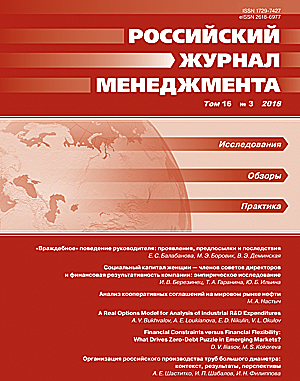Financial Constraints versus Financial Flexibility: What Drives Zero-Debt Puzzle in Emerging Markets?
DOI:
https://doi.org/10.21638/spbu18.2018.305Аннотация
Данное исследование сфокусировано на пробелах в теории формирования структуры капитала, касающихся мотивов выбора нулевого уровня долга. На выборке компаний из 21 страны с развивающимися рынками капитала за период с 2010 по 2015 г. мы проследили, что выбор политики структуры капитала обусловлен в первую очередь мотивом финансовой гибкости. Вторым по значимости мотивом являются финансовые ограничения. Мы определили, что основными детерминантами выбора нулевого долга являются возможности роста, бизнес-риск, доходность компании и наличие у компании денежных средств. Наши результаты показали, что компании с нулевым долгом зачастую малого размера, менее прибыльные, более рисковые и располагают высокими денежными ресурсами. Нами установлено, что внутрикорпоративные факторы более значимы при выборе нулевого долга, чем макроэкономические условия.
Ключевые слова:
финансовые ограничения, финансовая гибкость, нулевой долг, структура капитала
Скачивания
Библиографические ссылки
REFERENCES
Загрузки
Опубликован
Как цитировать
Выпуск
Раздел
Лицензия
Статьи журнала «Российский журнал менеджмента» находятся в открытом доступе и распространяются в соответствии с условиями Лицензионного Договора с Санкт-Петербургским государственным университетом, который бесплатно предоставляет авторам неограниченное распространение и самостоятельное архивирование.





